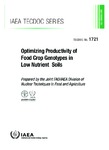Please use this identifier to cite or link to this item:
http://www.alice.cnptia.embrapa.br/alice/handle/doc/979294| Title: | Phosphorus use efficiency by brazilian common bean genotypes assessed by the 32P dilution technique. |
| Authors: | FRANZINI, V. I.  MURAOKA, T.   ADU-GYAMFI, J. J.   LYNCH, J. P.   |
| Affiliation: | VINICIUS IDE FRANZINI, CPATU; T. MURAOKA, CENA/USP; J.J ADU-GYAMFI, International Atomic Energy Agency; J.P. LYNCH, Pennsylvania State University. |
| Date Issued: | 2013 |
| Citation: | In: OPTIMIZING productivity of food crop genotypes in low nutrient soils. Vienna: FAO: IAEA, 2013. |
| Pages: | p. 103-118. |
| Description: | The objectives of this work were to identify the most efficient common bean (Phaseolus vulgaris L.) genotypes on phosphorus (P) utilization, and verify if P from the seed affects the classification of common bean genotypes on P uptake efficiency when the 32P isotopic dilution technique is used. The experiment was conducted in a greenhouse, and plants were grown in pots with surface samples of a dystrophic Typic Haplustox. The treatments consisted of 50 common bean genotypes and two standard plant species, efficient or inefficient in P uptake. The results were assessed through correlation and cluster analysis (multivariate). Sangue de Boi, Rosinha, Thayú, Grafite, Horizonte, Pioneiro and Jalo Precoce common bean genotypes were the most efficient on P uptake, and Carioca 80, CNF 10, Pérola, IAPAR 31, Roxão EEP, Aporé, Pioneiro, Pontal, Timbó and Rudá were the most efficient in P utilization. The P derived from seed influences the identification of common bean genotypes for P uptake efficiency. |
| Thesagro: | Feijão Fósforo |
| Series/Report no.: | (IAEA Tecdoc, 1721). |
| Type of Material: | Parte de livro |
| Access: | openAccess |
| Appears in Collections: | Capítulo em livro científico (CPATU)  |










